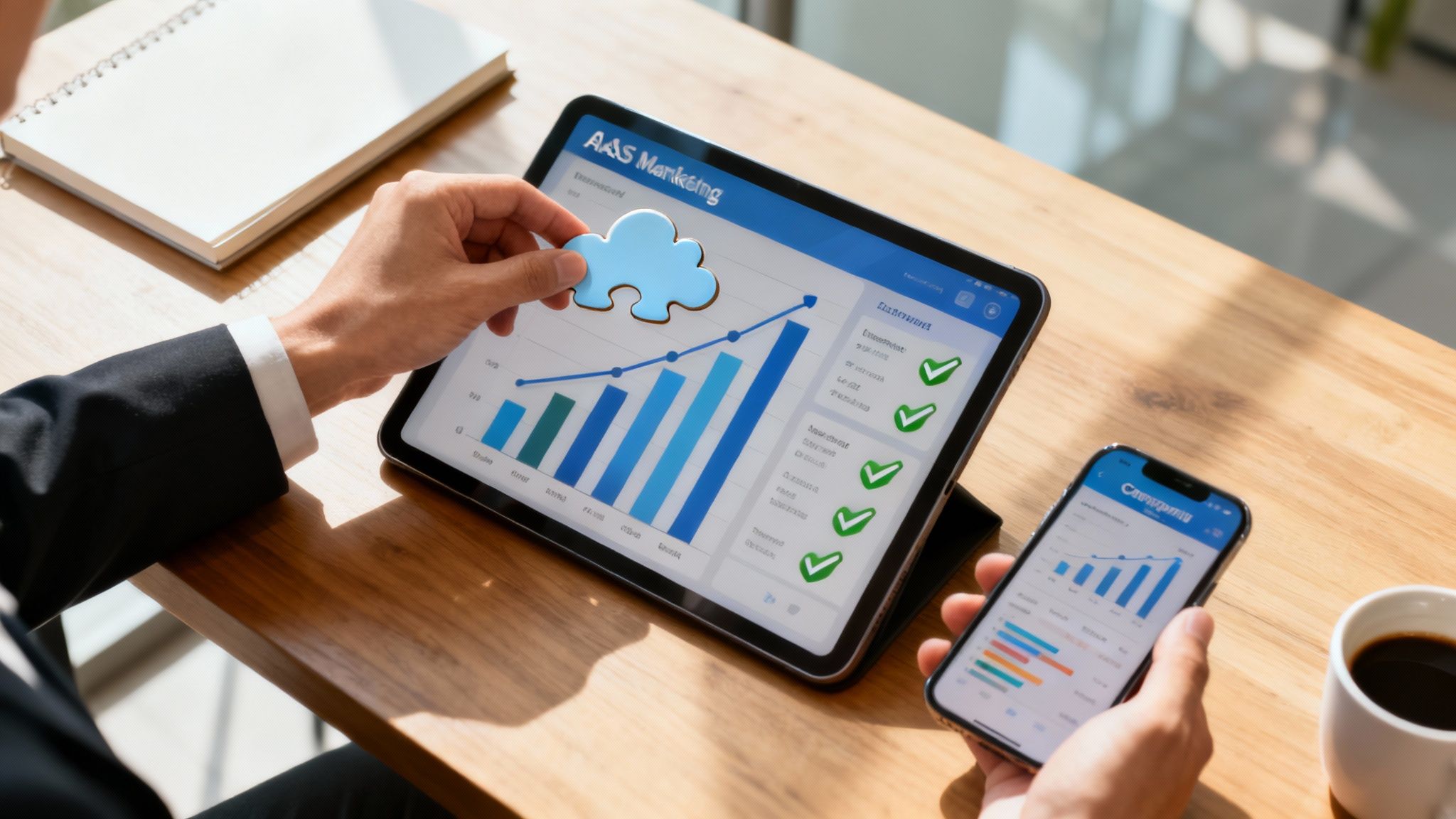A B2B SaaS marketing agency is more than just another marketing partner. They are specialists who live and breathe the unique world of the SaaS business model—from managing churn and obsessing over annual recurring revenue (ARR) to navigating complex sales cycles.
These agencies move beyond generic playbooks to build strategies designed specifically for subscription-based software. In a crowded market, that specialized focus is precisely what you need to gain and maintain a competitive edge.
Why a Specialized B2B SaaS Marketing Agency Matters

Choosing a marketing partner isn’t about offloading tasks; it’s about finding a co-pilot for your growth journey. For any B2B SaaS company, the stakes are incredibly high.
A generalist digital marketing agency might know how to run a Google Ads campaign, but do they understand the delicate balance of lowering customer acquisition cost (CAC) while maximizing lifetime value (LTV)? This is where a specialized agency transitions from a luxury to a strategic necessity.
These agencies already speak your language. You won't waste valuable time explaining metrics like MRR, ARR, or churn rates. They build strategies to impact those numbers from day one because their expertise is purpose-built for the subscription economy.
Moving Beyond Generalist Tactics
A generalist firm might celebrate driving a surge of top-of-funnel traffic, which sounds impressive but often fails to convert into paying, long-term users. A specialized agency knows better. They understand the critical difference between generating a lead and acquiring a loyal, high-value customer.
Their approach is built around the entire customer lifecycle, not just the initial sale. They know that for a SaaS business, success means:
- Navigating long sales cycles involving multiple decision-makers, demanding sophisticated, patient lead nurturing.
- Battling churn by attracting the right customers who will stick around for the long haul.
- Mastering product-led growth (PLG), where the product itself becomes one of your most powerful marketing tools.
- Scaling recurring revenue through smart, targeted upselling and cross-selling initiatives.
The real advantage of a niche agency is its deep, concentrated experience. They've already tackled the same challenges you're facing for dozens of other SaaS companies, allowing them to anticipate roadblocks and deploy proven solutions faster.
This deep industry knowledge is invaluable in an exploding market. Business spending on SaaS solutions was projected to hit $240.61 billion in 2022, a figure forecasted to surpass $720 billion by 2028.
With nearly 99% of organizations worldwide using at least one SaaS tool, standing out requires more than standard-issue marketing.
Ultimately, a specialized B2B SaaS marketing agency delivers the strategic clarity needed to not just compete, but thrive. They ensure every marketing dollar is tied directly to activities that support your unique business model—a vital component of any effective B2B SaaS marketing strategy. This focused approach is the key to unlocking sustainable growth and carving out a true competitive edge.
Defining What Your SaaS Actually Needs From an Agency
Before you begin searching for a B2B SaaS marketing agency, the most critical work happens internally. Without a clear picture of your own needs, every agency pitch will sound compelling, making it nearly impossible to distinguish a great fit from a poor investment. You must move beyond a vague wishlist and build a precise brief that connects marketing functions to tangible business goals.
This isn't just about listing perceived gaps like "better SEO" or "more leads." It’s about diagnosing the root cause of your growth plateau. Are you struggling to attract the right audience, or is the problem that your existing traffic isn't converting? Pinpointing these specific gaps is the only way to find a partner who can deliver real value.
Aligning Services with Your Growth Stage
The marketing an early-stage startup needs while seeking product-market fit is vastly different from what a scale-up requires to capture market share. One focuses on brand building and foundational organic traffic; the other demands a sophisticated machine for generating and converting high-value leads. A one-size-fits-all approach is a fast track to a drained marketing budget.
Consider which of these categories your company falls into:
- Early-Stage (Pre-Product-Market Fit): Your primary goal is validation and getting on the radar. The focus should be on foundational content that educates the market, builds a core audience, and drives those first crucial organic visitors. Key services include content strategy, on-page SEO, and building a targeted social media presence.
- Growth Stage (Post-Product-Market Fit): You have a product people want, and now it's all about scalable customer acquisition. This is where demand generation is paramount. An agency should be laser-focused on building a predictable lead pipeline through paid media, advanced SEO targeting bottom-of-funnel keywords, and marketing automation for lead nurturing.
- Scale-Up (Expansion Phase): The mission is market leadership and moving upmarket to larger accounts. Your needs will shift to advanced strategies like account-based marketing (ABM) to land enterprise clients, conversion rate optimization (CRO) to maximize value from existing traffic, and cementing your brand’s authority.
Identifying your current stage helps you create a clear, actionable brief. This document not only steers your search but also forces you to clarify your priorities and define what success looks like in six or twelve months. It transforms the conversation with a potential B2B SaaS marketing agency from a generic sales pitch into a strategic discussion about your specific business goals.
Before starting outreach, map your current growth stage to the marketing services that will deliver the biggest impact. This ensures you're not paying for tactics you don't need yet or overlooking foundational work critical for your next phase of growth.
Matching Agency Services to Your SaaS Growth Stage
Using a framework like this helps you create a scorecard for evaluating agencies, ensuring their core competencies align perfectly with where your business is headed.
Beyond the Basics: What Modern SaaS Marketing Requires
Today’s market demands much more than traditional channel expertise. The role of AI in B2B SaaS marketing, for example, is no longer a "nice-to-have." New data shows 81% of B2B marketers now use generative AI tools—a massive jump from just a year ago. Top SaaS marketers are using AI for real-time personalization, programmatic SEO, and predictive analytics to match content with true buyer intent. You can find more on this in these recent SaaS content marketing statistics.
An effective agency partner won't just execute tasks; they will challenge your assumptions and bring new ideas to the table. They should be fluent in the technologies and methodologies shaping the future of SaaS growth.
This is why your brief should also outline your tech stack and internal capabilities. Do you have a CRM? Are your marketing and sales data integrated? An agency needs this context to propose solutions that will function effectively within your existing ecosystem.
Ultimately, defining your needs is about creating a scorecard. When you know exactly what you’re looking for—whether it’s building a demand gen engine from the ground up or refining your ABM playbook—you can evaluate potential partners with confidence. This clarity is your best defense against empty promises and your surest path to finding an agency that can help you hit your most ambitious growth targets. Exploring proven B2B SaaS marketing strategies can also provide more ideas as you build your requirements.
How to Properly Vet a B2B SaaS Marketing Agency
You’ve got your shortlist of agencies. Now the real work begins.
It's time to move past polished sales pitches and slick websites. This part of the process is all about structured vetting. You're not just looking for a vendor; you're qualifying a strategic partner who can actually move the needle for your business.
The goal here is to get to the truth—to see their real expertise, dissect their processes, and determine if they'll be a good cultural fit. A killer presentation means nothing if the team behind it can't deliver. Your job is to ask the tough questions and find proof in the right places.
This chart lays out a simple, three-step framework for getting your own house in order before you even start talking to agencies.
When you start with a solid internal assessment, define crystal-clear goals, and create a detailed brief, you walk into those conversations from a position of strength.
Analyzing Case Studies Beyond Vanity Metrics
Every agency will show you case studies highlighting their greatest hits. Your job is to look past flashy, surface-level wins like "we increased organic traffic by 300%." That number sounds great, but without context, it’s meaningless.
A truly competent B2B SaaS marketing agency will connect every result back to tangible business outcomes. You need to push them to connect those dots.
Here’s what you should be digging for:
- MQL-to-SQL Conversion Rates: Did all that new traffic actually turn into qualified leads that your sales team wanted to engage? A revenue-focused agency will have this number ready.
- Customer Acquisition Cost (CAC): Ask them how their work impacted CAC. A successful campaign should lower this cost or, at the very least, keep it steady while scaling lead flow.
- Lifetime Value (LTV): Did the customers they helped acquire actually stick around? Inquire about the LTV of the cohorts they brought in versus other channels. This shows they’re thinking about customer quality, not just lead quantity.
If an agency gets cagey or can't speak to these metrics, it’s a massive red flag. It signals they’re stuck at the top of the funnel and don’t take ownership of how their work translates to revenue.
A great case study isn't just about big numbers; it tells a story. It should walk you through the initial challenge, the strategy they deployed, and the real, measurable impact on the client's growth—all backed by hard data.
Asking Insightful Questions to Uncover Their Process
Those initial calls are your chance to dig into how an agency thinks and operates. Your questions should be designed to get them off their script and reveal how they actually work.
Come prepared with a list of questions that test their strategic capabilities.
Questions About Their Strategy and Expertise:
- Can you walk me through your process for the first 90 days with a new SaaS client like us?
- How do you pivot when a channel isn't performing as expected?
- Tell me about a time you had to inform a client their existing strategy was flawed. How did you handle that conversation?
- What marketing automation and analytics platforms are you experts in, and why do you prefer them?
These questions are designed to reveal their adaptability, honesty, and technical know-how. Remember, you're not just hiring a pair of hands to execute tasks; you’re looking for a strategic advisor. The quality of their answers will tell you everything you need to know about whether they can fill that role. You can learn more about what a true partnership looks like when you find a data-driven marketing agency that prioritizes transparency.
Speaking with Current and Past Clients
References are perhaps the most powerful tool in your vetting process. While an agency will always provide their happiest clients, you can still gain incredible value by asking the right questions.
Don't just ask if they were "happy" with the work. Get specific.
- Communication and Reporting: "How proactive was the agency with communication? What did their reports look like, and was it easy to see how their work was impacting our goals?"
- Problem Resolution: "Can you tell me about a time a campaign went off track? How did the agency handle it and what did they do to resolve the issue?"
- Strategic Contribution: "Did the agency feel like an extension of your team? Did they just execute requests, or did they actively bring new ideas to the table?"
Listen not only for what they say but also for what they don't say. A slight hesitation or a vague answer can be just as telling as direct criticism. This final step gives you an unfiltered look into what it's really like to work with them, helping you make a final decision based on real-world experience, not just a sales pitch.
Decoding Agency Pricing Models for Your Budget
Agency pricing can feel like a black box, making it tough to compare partners and plan your marketing spend. You’ll encounter retainers, project-based fees, and performance models—so which one is right? Let's unpack them so you can find a financial structure that fuels growth instead of causing friction.
Choosing the right model isn't just about the dollar amount. It’s about ensuring your agency’s incentives are perfectly aligned with your business goals. A mismatch here can lead to misaligned priorities and disappointing results.
The Monthly Retainer Model
The monthly retainer is the most common structure you'll find when looking for a B2B SaaS marketing agency. It’s straightforward: you pay a fixed fee each month for an agreed-upon scope of work. This typically covers ongoing activities like SEO, content creation, and paid media management.
This model is built for long-term, compounding efforts. SEO and content marketing aren't one-off tasks; they build momentum over time. A retainer gives an agency the stability to dedicate a team to your success, constantly analyzing data and optimizing campaigns.
The primary benefit is the deep partnership it fosters. Your agency becomes an extension of your team, learning your product, customers, and market inside and out. This allows them to be more proactive and strategic. Plus, the predictable cost simplifies budgeting.
Project-Based and Fixed-Scope Fees
In contrast, project-based pricing is for specific, well-defined initiatives with a clear start, end, and deliverable. This is ideal for tasks like a complete website redesign, CRM migration, or building a new set of sales enablement materials.
You pay a fixed price for a specific outcome. The main advantage is clarity: you know exactly what you’re getting and what it will cost. It's a great fit for immediate needs when you aren't ready for a long-term engagement.
However, this model is not ideal for ongoing marketing. Once the project is over, the work stops, which can create a stop-and-start motion that hinders sustainable growth.
The key is to match the pricing model to the marketing function. A fixed-scope project is perfect for a website migration, but a monthly retainer is necessary for the sustained SEO and content efforts that will make that new website valuable over time.
Performance-Based and Hybrid Models
A less common but compelling option is the performance-based model. Here, the agency's compensation is directly tied to hitting specific KPIs, such as MQLs generated or even closed-won revenue. This setup perfectly aligns their financial success with yours.
However, this model often comes with a higher base fee to offset the agency's risk. It also requires crystal-clear tracking and attribution, which can be complex in B2B SaaS where sales cycles are long and involve multiple touchpoints.
A hybrid model often strikes the best balance, combining a lower monthly retainer with performance bonuses. This provides the agency with stable cash flow while giving them a powerful incentive to drive tangible results. It's a shared-risk approach that can build a strong, results-focused partnership.
To help you weigh the options, here’s a quick breakdown of how these common pricing structures stack up.
Comparing Common B2B SaaS Agency Pricing Models
Ultimately, the goal is to find a model that makes sense for your stage of growth and the specific marketing functions you need help with.
Success in SaaS often comes down to converting users, yet a 2025 analysis revealed that 55.4% of B2B SaaS companies feel their free-to-paid conversion capability is below average. Interestingly, the same research shows that companies with systematic, self-serve revenue models score 25.9% higher on conversion. This highlights the need for expert marketing that directly supports your revenue goals. You can see more in the full B2B SaaS report. Understanding how an agency's pricing connects to these crucial conversion goals is key. To get a better sense of how costs translate to value, check out this digital marketing services cost-benefit breakdown.
Building a Successful Partnership From Day One

You’ve signed the contract with your new B2B SaaS marketing agency. The real work—and the true test of your partnership—is just beginning. The first 90 days are absolutely critical. They set the tone, build momentum, and lay the foundation for everything that follows.
Get it right, and you're on the path to a seamless, collaborative growth engine. Get it wrong, and you’re facing months of friction, mismatched expectations, and lackluster results.
The key is to move beyond a simple hand-off. You need to actively co-create the partnership from day one. This isn’t just about the agency learning your business; it’s about both sides building the operational and communication frameworks to move fast and win together. A smooth start is intentional, not accidental.
Kicking Off With a Deep-Dive Discovery Session
The first item on the agenda should be an intensive discovery session. This is more than a quick recap of your goals. A great agency will facilitate a workshop designed to extract deep institutional knowledge, challenge your assumptions, and align everyone on a unified vision.
This is where you clarify all the details that didn't make it into the sales calls. The agency needs to understand more than just what you sell. They need the nuances of why customers choose you over the competition, the internal team dynamics, and the real story behind past marketing wins and failures.
The goal of discovery isn't just to transfer information; it's to establish shared context. When your agency understands the "why" behind your business decisions, they can operate with more autonomy and make smarter strategic calls.
To make this session count, you must show up prepared. Don't wait for the agency to ask for everything. Proactively arming them with the right assets is the fastest way to get them up to speed and working on things that move the needle.
Your Pre-Onboarding Preparation Checklist
Before the first official meeting, gather these items to hit the ground running:
- Analytics and CRM Access: Grant permissions to Google Analytics, Search Console, your CRM (like Salesforce or HubSpot), and any marketing automation platforms. Data access is non-negotiable for a data-driven partner.
- Brand Guidelines and Assets: Provide your official brand book, logos, fonts, and any existing creative to ensure consistency from day one.
- Buyer Personas and ICPs: Share all documentation on ideal customer profiles and buyer personas. If these aren’t formalized, be ready to workshop them.
- Past Performance Reports: Give them access to previous marketing reports and campaign results. Hiding past failures helps no one; it's crucial data they can learn from.
For a deeper dive into making this initial phase as effective as possible, our guide on client onboarding best practices offers a structured approach.
Defining KPIs and a Communication Cadence
Once the foundational knowledge is established, the next task is to define exactly how you'll measure success and communicate progress. This is where many partnerships begin to fray. Vague goals and sporadic updates are a recipe for frustration.
Work with your agency to lock in a clear set of Key Performance Indicators (KPIs) that tie directly to your business objectives. Move past vanity metrics like "traffic" and focus on the numbers that actually matter:
- Marketing Qualified Leads (MQLs)
- Sales Qualified Leads (SQLs)
- MQL-to-SQL Conversion Rate
- Pipeline Value Generated
- Customer Acquisition Cost (CAC)
Alongside these metrics, establish a firm communication rhythm. This means setting up a shared channel (like a dedicated Slack channel) for daily questions and scheduling regular check-in calls. A typical cadence might include a weekly tactical sync and a monthly strategic review.
This structure ensures everyone stays aligned and that small issues are resolved before they become major problems. By fostering proactive collaboration and setting mutual expectations, you build a partnership designed for real, measurable growth from the start.
Common Questions We Get Asked
Choosing a B2B SaaS marketing agency is a significant decision, and it naturally comes with many questions. Let's tackle some of the most common ones we hear to help you find the right growth partner.
How Long Does It Really Take to See Results?
This is a critical question, and the honest answer is: it depends entirely on the strategy. It's essential to have realistic expectations tied to the specific marketing channels you and your agency decide to prioritize.
Think of SEO and content marketing as long-term investments. You're building an asset—your brand's authority and organic footprint. You should start seeing meaningful traction and a noticeable lift in qualified organic traffic within 6-9 months. The best part? The effort compounds, and the value continues to grow over time.
Conversely, paid advertising on platforms like LinkedIn or Google Ads can generate leads and demo requests much faster, often within the first 1-3 months. A great agency partner will build a blended strategy. They’ll create a roadmap showing you the quick wins from paid channels while mapping out the long-term growth milestones you'll achieve with your organic efforts.
What’s a Realistic Marketing Budget?
There's no single magic number. Your marketing budget should be a direct reflection of your growth stage and objectives. However, some reliable benchmarks can guide you.
- Early-Stage Startups: If you're still finding your footing and aiming to capture market share, you'll need to invest more aggressively, typically allocating 20-30% of your annual recurring revenue (ARR) to marketing.
- Established Companies: For more mature SaaS businesses with a stable market position, that number often settles closer to 10-15% of ARR.
As for agency retainers, they can vary widely. You might find basic packages starting around $5,000 per month. For a comprehensive, multi-channel strategy designed for a scale-up, it's not uncommon to see retainers exceeding $30,000 per month. The most important thing is to be upfront about your budget. This ensures you find a partner whose scope and pricing align with your financial reality.
The biggest mistake is underfunding marketing while expecting world-class results. Be honest about what your budget can achieve. The right agency will help you maximize every dollar, but they can't perform miracles without adequate resources.
Is It Better to Go with a Niche Agency or a Full-Service One?
For nearly every B2B SaaS company, a specialized, niche agency is the smarter choice. The reason is simple: they already live and breathe your business model.
They don't need a crash course on ARR, LTV, churn, or CAC. They get it. Their expertise is laser-focused on solving the unique challenges of selling subscription software. A large, full-service agency might offer a wider menu of services, but they often lack the deep, nuanced understanding needed for great SaaS marketing. This frequently leads to generic campaigns that don't connect with a technical audience or account for a long, complex sales cycle.
Ultimately, a niche B2B SaaS marketing agency almost always delivers a better return on investment because their strategies are built from the ground up for your specific world.
What Are the Biggest Red Flags When Hiring an Agency?
Knowing what to look for is half the battle. Knowing what to avoid can save you from a very expensive headache. Keep an eye out for these red flags during your vetting process:
- Guaranteed Results: Marketing is not a perfect science. Any agency that guarantees outcomes, especially metrics like #1 SEO rankings, isn't being transparent. There are too many variables.
- Vague Case Studies: If their case studies are filled with vanity metrics (like "impressions" or "traffic increases") but lack actual business data (like MQLs, SQLs, or pipeline value), it's a problem.
- A One-Size-Fits-All Pitch: A true partner will be intensely curious about your business, customers, and goals. If they jump straight to a generic solution without asking insightful questions, they're selling a product, not a partnership.
Ready to partner with a B2B SaaS marketing agency that's focused on real business growth? Twelverays blends data-driven strategy with deep industry expertise to deliver results that matter. Schedule your free consultation today and let's talk about building your revenue engine.





